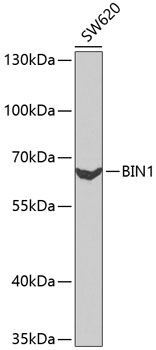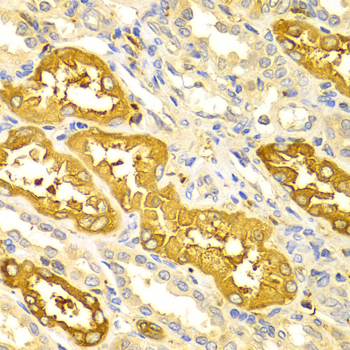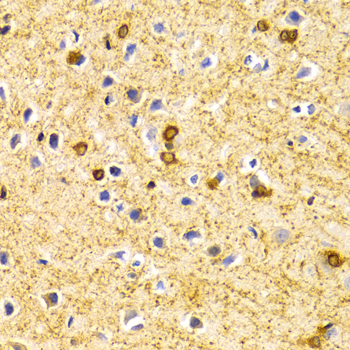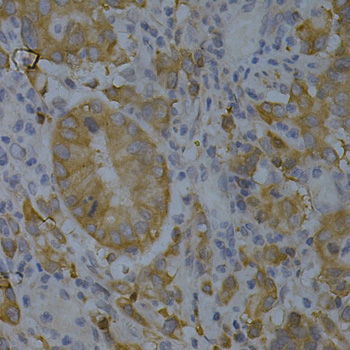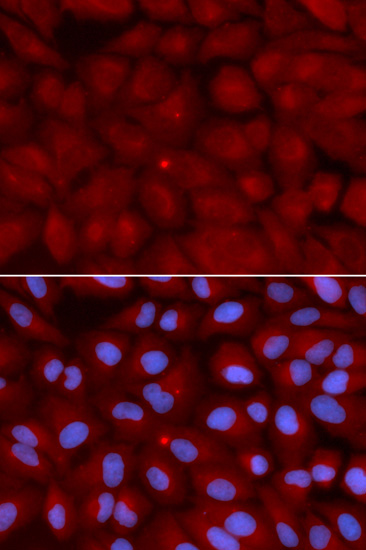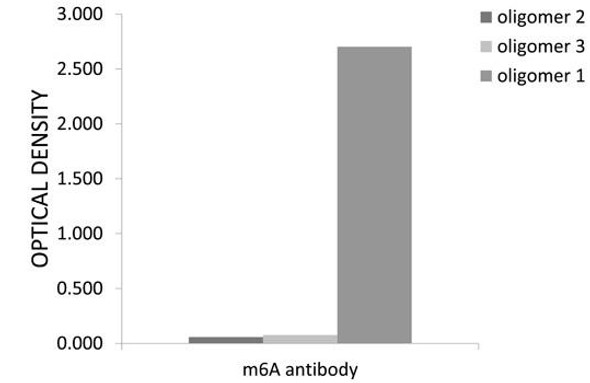Anti-BIN1 Antibody (CAB1792)
- SKU:
- CAB1792
- Product type:
- Antibody
- Reactivity:
- Human
- Rat
- Host Species:
- Rabbit
- Isotype:
- IgG
- Antibody Type:
- Polyclonal Antibody
- Research Area:
- Developmental Biology
Frequently bought together:
Description
| Antibody Name: | Anti-BIN1 Antibody |
| Antibody SKU: | CAB1792 |
| Antibody Size: | 20uL, 50uL, 100uL |
| Application: | WB IHC IF |
| Reactivity: | Human, Rat |
| Host Species: | Rabbit |
| Immunogen: | Recombinant fusion protein containing a sequence corresponding to amino acids 230-409 of human BIN1 (NP_647601.1). |
| Application: | WB IHC IF |
| Recommended Dilution: | WB 1:500 - 1:2000 IHC 1:50 - 1:200 IF 1:20 - 1:50 |
| Reactivity: | Human, Rat |
| Positive Samples: | SW620 |
| Immunogen: | Recombinant fusion protein containing a sequence corresponding to amino acids 230-409 of human BIN1 (NP_647601.1). |
| Purification Method: | Affinity purification |
| Storage Buffer: | Store at -20°C. Avoid freeze / thaw cycles. Buffer: PBS with 0.02% sodium azide, 50% glycerol, pH7.3. |
| Isotype: | IgG |
| Sequence: | QNLN DVLV GLEK QHGS NTFT VKAQ PSDN APAK GNKS PSPP DGSP AATP EIRV NHEP EPAG GATP GATL PKSP SQSS LPAV VVET FPAT VNGT VEGG SGAG RLDL PPGF MFKV QAQH DYTA TDTD ELQL KAGD VVLV IPFQ NPEE QDEG WLMG VKES DWNQ HKEL EKCR GVFP ENFT ERVP |
| Gene ID: | 274 |
| Uniprot: | O00499 |
| Cellular Location: | Cytoplasm, Nucleus |
| Calculated MW: | 45-64kDa |
| Observed MW: | 65kDa |
| Synonyms: | BIN1, AMPH2, AMPHL, SH3P9 |
| Background: | This gene encodes several isoforms of a nucleocytoplasmic adaptor protein, one of which was initially identified as a MYC-interacting protein with features of a tumor suppressor. Isoforms that are expressed in the central nervous system may be involved in synaptic vesicle endocytosis and may interact with dynamin, synaptojanin, endophilin, and clathrin. Isoforms that are expressed in muscle and ubiquitously expressed isoforms localize to the cytoplasm and nucleus and activate a caspase-independent apoptotic process. Studies in mouse suggest that this gene plays an important role in cardiac muscle development. Alternate splicing of the gene results in several transcript variants encoding different isoforms. Aberrant splice variants expressed in tumor cell lines have also been described. |
| UniProt Protein Function: | BIN1: May be involved in regulation of synaptic vesicle endocytosis. May act as a tumor suppressor and inhibits malignant cell transformation. Defects in BIN1 are the cause of centronuclear myopathy type 2 (CNM2). A congenital muscle disorder characterized by progressive muscular weakness and wasting involving mainly limb girdle, trunk, and neck muscles. It may also affect distal muscles. Weakness may be present during childhood or adolescence or may not become evident until the third decade of life. Ptosis is a frequent clinical feature. The most prominent histopathologic features include high frequency of centrally located nuclei in muscle fibers not secondary to regeneration, radial arrangement of sarcoplasmic strands around the central nuclei, and predominance and hypotrophy of type 1 fibers. 11 isoforms of the human protein are produced by alternative splicing. |
| UniProt Protein Details: | Protein type:Tumor suppressor; Cytoskeletal; Adaptor/scaffold; Vesicle Chromosomal Location of Human Ortholog: 2q14 Cellular Component: I band; synaptic vesicle; membrane; axon; T-tubule; cytoplasm; nerve terminal; Z disc; nucleus; actin cytoskeleton Molecular Function:identical protein binding; protein binding; GTPase binding; protein heterodimerization activity; protein complex binding; tau protein binding Biological Process: cell proliferation; muscle cell differentiation; viral reproduction; regulation of neuron differentiation; positive regulation of apoptosis; positive regulation of endocytosis; endocytosis; positive regulation of GTPase activity; positive regulation of astrocyte differentiation Disease: Myopathy, Centronuclear, 2 |
| NCBI Summary: | This gene encodes several isoforms of a nucleocytoplasmic adaptor protein, one of which was initially identified as a MYC-interacting protein with features of a tumor suppressor. Isoforms that are expressed in the central nervous system may be involved in synaptic vesicle endocytosis and may interact with dynamin, synaptojanin, endophilin, and clathrin. Isoforms that are expressed in muscle and ubiquitously expressed isoforms localize to the cytoplasm and nucleus and activate a caspase-independent apoptotic process. Studies in mouse suggest that this gene plays an important role in cardiac muscle development. Alternate splicing of the gene results in ten transcript variants encoding different isoforms. Aberrant splice variants expressed in tumor cell lines have also been described. [provided by RefSeq, Sep 2011] |
| UniProt Code: | O00499 |
| NCBI GenInfo Identifier: | 14916535 |
| NCBI Gene ID: | 274 |
| NCBI Accession: | O00499.1 |
| UniProt Secondary Accession: | O00499,O00297, O00545, O43867, O60552, O60553, O60554 O60555, O75514, O75515, O75516, O75517, |
| UniProt Related Accession: | O00499 |
| Molecular Weight: | 593 |
| NCBI Full Name: | Myc box-dependent-interacting protein 1 |
| NCBI Synonym Full Names: | bridging integrator 1 |
| NCBI Official Symbol: | BIN1 |
| NCBI Official Synonym Symbols: | AMPH2; AMPHL; SH3P9 |
| NCBI Protein Information: | myc box-dependent-interacting protein 1; amphiphysin II; amphiphysin-like protein; box dependant MYC interacting protein 1; box-dependent myc-interacting protein 1 |
| UniProt Protein Name: | Myc box-dependent-interacting protein 1 |
| UniProt Synonym Protein Names: | Amphiphysin II; Amphiphysin-like protein; Box-dependent myc-interacting protein 1; Bridging integrator 1 |
| Protein Family: | Myc box-dependent-interacting protein |
| UniProt Gene Name: | BIN1 |
| UniProt Entry Name: | BIN1_HUMAN |


